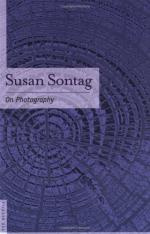
|
| Name: _________________________ | Period: ___________________ |
This test consists of 5 multiple choice questions, 5 short answer questions, and 10 short essay questions.
Multiple Choice Questions
1. American photographers feel the country is simply too _______ to be understood - instead it must simply be catalogued.
(a) Important.
(b) Old.
(c) Good.
(d) Big.
2. Diane Arbus is discussed as having been one to photograph the ____________ of society.
(a) Dark corners.
(b) Ignored.
(c) Freaks.
(d) Rich.
3. _____________ often use cameras and practice photography as a method of certifying their travel experience.
(a) Children.
(b) Men.
(c) Women.
(d) Tourists.
4. The surrealist movement courts _________ and incongruous juxtaposition in its use.
(a) Justice.
(b) Accidents.
(c) Reality.
(d) Truth.
5. People with _________ are more likely to have cameras than people who do not have them.
(a) Mothers.
(b) Children.
(c) Pets.
(d) Cars.
Short Answer Questions
1. What picture of Steichen's was composed of portraiture that showed the universal in the individual?
2. Camera use is especially pronounced in tourists who come from cultures that stress activity and ______________.
3. Photography has become a bit of a surrealist art, not a/an __________ art, but close to it, according to Sontag.
4. Unlike what the previous parts of the chapter say, Sontag goes on to say that photography can inform ____________.
5. Photographs also warp our sense of _________ as they are always minute in comparison to the real object.
Short Essay Questions
1. What was Whitman's cultural and social influence, coined Whitmanesque, according to the text?
2. How might the surrealist art movement be described, according to Sontag in this chapter?
3. What does Surrealism strive to do in society, much like the goals of photography in the world?
4. What did Steichen thus do with his photographs in terms of creating importance with the subject of the picture?
5. How does photography make the photographer incapable of intervening in a situation?
6. On what other artistic areas does photography impose standards according to Sontag in this chapter?
7. Why did photography come to be seen as a type of copulation with the material world?
8. How was "Family of Man" an opposite representation of what Whitman was trying to saw about humanity?
9. What did Edward Steichen photograph in order to show that objects aren't always as simple as they appear?
10. How are photographs usually held as definitive evidence in the world, according to Sontag?
|
This section contains 547 words (approx. 2 pages at 300 words per page) |

|




